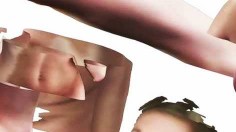LILLA LOCURTO AND BILL OUTCAULT
morning star evening star
source: anti-utopias
We were invited by an alternative art space in Berlin, Germany, to create a three-channel video installation. This video, flâneur, draws upon the time between 1890 and the mid 1930′s and encompass Neoclassicism, Jugendstil and Modernism by using the architecture, dance, music and philosophy of the period. As we researched the era, we came to realize that during these years, Berlin had grown rapidly into a very cosmopolitan city and radical changes had occurred. We found numerous unexpected similarities to our work that made that time particularly resonant to us. The handling of volume, space and proportion in the Neoclassicism of the late 19th century was familiar from our work with the digitized human figure. We found a connection as well within the Jugendstil, or German Art Nouveau, especially in the typography and music that was related to it. The typography was one of its distinguishing characteristics and in a number of ways it relates visually as well as conceptually to our 21st century work and with what we see as the typography inherent in the human form. The style’s organic, floral appearance was inspired by nature and the resulting curvilinear froms are evocative of our digital sectioning of the three-dimensional human figure. Modernism that followed brought with it an acceptance of technologies that allowed one to reconfigure and re-imagine the world in ways unforeseen until then, much as modern digital technology has impacted the world today.
As foreigners looking voyeuristically into this culture we appropriated the French term “flâneur” to describe an outsider’s experience of the city. For the video we plan to move through that era using digital avatar/marionettes created using motion capture technology and three-dimensional scans of dance performers. These marionettes have the advantage of being weightless, a property most resistant to dance, and they will appear graceful, without the consciousness that afflicts their human counterparts. flâneur will take the viewer through the cultural changes sweeping the era using these marionettes and three-dimensional architectural models. We plan to deconstruct both the human and the architectural models similarly to the way we have treated the figure in the past, to rupture, puncture, section and unfold their skins as a means to re-visualize them and to explore their volumes in unique ways. We are approaching the narrative of the piece as a fairy tale and collage. By referencing two writers of the period, Friedrich Nietzsche and his influential approach to architecture, and Carlo Collodi, author of The Adventures of Pinocchio, we intend to abstract and meld these divergent sources into a contemporary whole and to also introduce a sense of transcendence into the work.
.
.
.
.
.
.
.
.
.
source: you-ads
Duo d’artistes formé en 1991, Lilla LoCurto et Bill Outcault travaillent sur la fragilité du corps et de l’entité humaine. En 1999, ils utilisent à contre-emploi les scanners et ordinateurs pour explorer les caractéristiques corporelles de leur propre enveloppe. Leurs œuvres s’apparentent à des recherches anthropologistes et appellent une nouvelle cartographie du corps. Animations, dessins et photographies composent les différentes étapes artistiques du duo qui fait de la combinaison de l’art et de la technologie un véritable fer de lance.


